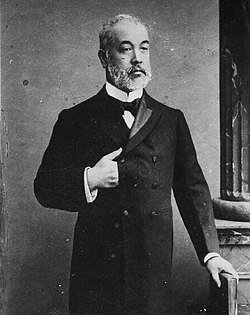Hayashi Tadasu
GCVO | |
|---|---|
林 董 | |
 Hayashi Tadasu c. 1902 | |
| Minister of Communications | |
| In office 30 August 1911 – 21 December 1912 | |
| Prime Minister | Saionji Kinmochi |
| Preceded by | Gotō Shinpei |
| Succeeded by | Gotō Shinpei |
| Minister for Foreign Affairs | |
| In office 19 May 1906 – 14 July 1908 | |
| Prime Minister | Saionji Kinmochi |
| Preceded by | Saionji Kinmochi |
| Succeeded by | Terauchi Masatake |
| Personal details | |
| Born | Satō Shingoro 11 April 1850 Sakura, Shimōsa, Japan |
| Died | 10 July 1913 (aged 63) Hayama, Kanagawa, Japan |
| Resting place | Aoyama Cemetery |
| Spouse | |
| Children | Fukuzawa Kiku (daughter) Hayashi Masanosuke (son) |
| Parent(s) | Satō Taizen (biological father) Hayashi Dokai (adoptive father) |
| Relatives | Matsumoto Ryōjun (brother) |
| Education | University College School |
| Alma mater | King's College London |
| Occupation | Diplomat, cabinet minister |
| Other names | Satō Tosaburō |
Early life
He was born Satō Shingoro in
From 1866 to 1868, Hayashi studied in Great Britain at University College School and King's College London as one of fourteen young Japanese students (including Kikuchi Dairoku) sent by the Tokugawa government on the advice of the then British foreign minister Edward Stanley, 15th Earl of Derby.
Hayashi returned home in the midst of the
Released in 1871 by Kanagawa governor
Government officer
Being a member of the Iwakura Mission in Britain, he was instructed by
Political career
After the Ministry of Public Works was abolished, he moved to the Ministry of Post and Telecommunication, then was appointed governor of Kagawa Prefecture, and then of Hyōgo Prefecture. In 1891, he was appointed Vice-Minister for Foreign Affairs. He was elevated to the title of baron (danshaku) in the kazoku peerage in 1895.
Hayashi was appointed as resident minister to the court of

On 2 December 1905 Hayashi became the first Japanese ambassador to the Court of St James's, as diplomatic relations were upgraded between the Empire of Japan and the British Empire.[3] He was accompanied by his wife.[6] At that time Sir Claude MacDonald was Hayashi's opposite number in Tokyo.
On becoming
On contracting diabetes, Hayashi retired in 1912, and in June 1913 he fractured his thigh in an accident, resulting in an amputation. Hayashi died a month later, and his grave is at Aoyama Cemetery in Tokyo.[7]
Personal life
In 1875, he married
Hayashi became a master mason in 1904, initiated in 1903 in Empire Lodge No. 2108, in London.[9] He resigned from the lodge in 1907.[9]
Honors
Titles
- Baron (31 October 1895)
- Viscount (27 February 1902)[10]
- Count (14 September 1907)
Decorations
- Grand Cordon of the Order of the Sacred Treasure (31 October 1895)
- Grand Cordon of the Order of the Rising Sun (27 December 1899)
- Grand Cordon of the Order of the Rising Sun with Paulownia Flowers (1 April 1906)
- Knight Grand Cross of the Royal Victorian Order (GCVO) (4 July 1905)[11]
Honorary degrees
- LL.D. (honorary) University of Cambridge – May 1902[12]
- D.C.L. (honorary) University of Oxford – June 1902[13]
Order of precedence
- Third rank (21 July 1901)
- Senior third rank (May 1910)
See also
- Japan–United Kingdom relations
- Henry Petty-Fitzmaurice, 5th Marquess of Lansdowne – who signed the Anglo-Japanese alliance of 30 January 1902 for Britain when Hayashi signed for Japan
- Japanese students in the United Kingdom
- Kikuchi Dairoku
- Imperial Rescript on Education
References
- The Secret Memoirs of Count Hayashi Tadasu, edited by A.M. Pooley, 1915, reprinted 2002 ISBN 1-4039-0334-4
- ISBN 0-8108-4927-5.
External links
- Portrait of Hayashi Tadasu on the website of the National Diet Library, Tokyo
- . Encyclopædia Britannica (11th ed.). 1911.
Notes
This article includes a list of general references, but it lacks sufficient corresponding inline citations. (September 2020) |
- ^ Who's Who 1914, p. xxii
- ISSN 0002-9300.
- ^ a b c d e Kowner, Historical Dictionary of the Russo-Japanese War, p. 144.
- ^ Chisholm, Hugh, ed. (1911). . Encyclopædia Britannica. Vol. 13 (11th ed.). Cambridge University Press. p. 109.
- ^ Hayashi Tadasu: Ato wa Mukashi no Ki (Looking Back), p.47.
- ^ "Sitter: Viscountess Hayashi, later Countess Hayashi, née Misao Gamo (1858–1942)". Lafayette Negative Archive.
- ^ a b
 Chisholm, Hugh, ed. (1922). "Hayashi, Tadasu". Encyclopædia Britannica. Vol. 31 (12th ed.). London & New York: The Encyclopædia Britannica Company. p. 344.
Chisholm, Hugh, ed. (1922). "Hayashi, Tadasu". Encyclopædia Britannica. Vol. 31 (12th ed.). London & New York: The Encyclopædia Britannica Company. p. 344.
- ^ John William Leonard, William Frederick Mohr, Frank R. Holmes, Herman Warren Knox, Winfield Scott Downs, eds., Who's who in New York City and State, Issue 2 (L. R. Hamersly 1905): 1013.
- ^ a b "TADASU HAYASHI THE JAPANESE DIPLOMAT WHO BECAME AN ENGLISH FREEMASON | Freemasonry Matters". 26 May 2016. Retrieved 10 July 2024.
- ^ "Latest intelligence – Japan". The Times. No. 36704. London. 1 March 1902. p. 7.
- ^ London Gazette, 4 July 1905
- ^ "University intelligence". The Times. No. 36779. London. 28 May 1902. p. 12.
- ^ "University intelligence". The Times. No. 36788. London. 7 June 1902. p. 9.
